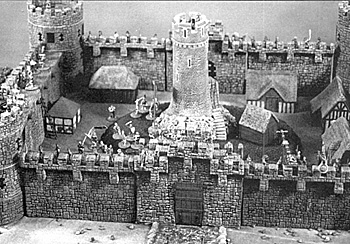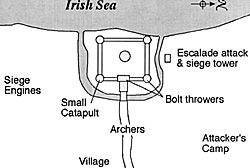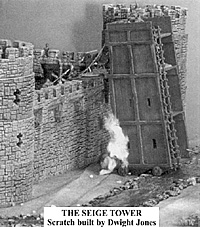Missile Fire
Tactica uses a basic method for resolving bow fire. For a target in the open, one bowman (there is no distinction between types) rolls 1D6, and on a six achieves a kill. A target behind a mantlet or other cover requires two bowmen rolling 1D6 for a six and so forth. Add the following: To hit a target behind a crenelle requires 4 bowmen; a target in a tower requires 5 bowmen, and a target behind an arrow slit requires 6 bowmen. For any fully armored knight, add one to the number.
Large Missile Fire (Trebuchets, bombards, catapults and bolt throwers)
These weapons can attack castle walls, siege engines and troops. Most die rolls damage the walls but also result in figure casualties. Playtests indicated that too many figures were being killed as the walls were pounded. Make the following change: when the chart indicates a loss of a DV (defensive value) and a kill or kills, reduce the wall or engine normally but make the kill number as possible kill(s). Roll 1D6 for each possible kill, on a six, the kill occurs.
Hand to Hand
Add peasants as a fighting class with a -1 modifier.
Filling the Moat
The rules as written allow 2 figures of any type to fill a 2" section of moat if they spend a full turn at the moat's edge. Suggested change: make fascines, (pine straw bundled and cut into small sections works nicely) and have the figures "carry" the fascines to the moat. This resolves the confusion as to which figures are carrying what, and whether or not the two figures have spent a turn at the moat. Obviously, if one half of a team becomes a casualty, then another figure can come in to help pick up the fascine.
Most of the above changes make the besieger's job more difficult. Pick and choose the ones which work best. Also, playtests have shown that tunneling is less than effective to the point where after several plays, it was no longer used.
If the attackers are successful in filling the moat and breaching the walls, then a number of knights, men-at-arms, and footmen await them. The attackers are not without means however. The Welsh Warlord has convinced his fellow lords that the time has come to oust the English, and he has arrayed a large number of troops and siege engines. It will be only a matter of time before the walls are breached and the castle taken.
The actual order of battle will be dependent upon the number of figures available, but a three to one attacker to defender ratio works about right. For the Siege of Castle Sikesmore, the attackers were divided into five mostly equal forces each under the command of a greater noble. A dominant color scheme was used for the various forces as it made it easier for the players to keep track of their troops. The attacker's infantry forces were placed within medium range of the castle and the attackers were given the option of where to place the siege engines. The defenders set up their forces last.
Attacking Forces
Break Points
Break points represent the time in the battle where one side or the other will give up the fight. In Castle Sikesmore, once a side's breakpoint reaches 50% of the number of troops, 2D6 are rolled. The breakpoint number or greater must be rolled or the game is over. The defender should always roll first. Finally, up to 12 turns are played. If the defenders are still fighting it is assumed that a relief force has arrived and the siege has been lifted.
Attacker's Break Points
Roll greater than or equal to the following numbers on two 2D6
Die Roll : Number of Points
Defender's Break Points
Turn One: The English defenders yield the first action as is their right and watch as the Welsh advance with scaling ladders along the north face. Meanwhile, archers, behind the cover of mantlets, darken the sky with arrows, as they harass troops atop the main gate. The Welsh Warlord, having placed his Trebuchet, medium catapult, and bombard to the south, begins to pound away at the southwest castle tower inflicting a few casualties along the way. The siege tower slowly advances from the north and the battering ram moves up the main road from the west. The defenders are only able to respond with withering bow fire and attempt to hit some Welsh bowmen with their small catapult and bolt thrower.
Turn Three: The ladder assaults stand and wait as areas of the northern moat begin to be filled with fascines. English casualties begin to mount at the northern wall. The southern west tower continues to be pounded and has now taken 18 of the 30 DV (defensive value) points needed to be breached. The Welsh switch a catapult to hammer the southern curtain wall. Although the English bolt thrower and catapult continue to cause some damage, the Welsh are now using their own bolt thrower to target artillery crews, which causes losses and reduces the effectiveness of the defending artillery. The siege tower is now within reach of the northern wall and waits only for the moat to be filled. The battering ram takes aim at the main gate but is still a ways down the road.
Turn Four: Things become a frenzy of activity as the Welsh try their ladder assault and suffer in the process. Although they are able to get a few men on the wall a counterattack drives them off and shoves the ladders aside. In the process, the greater noble for the Red force is killed fighting off 3 English men-at-arms. With the siege tower so near the Welsh give up on the escalade and regroup. 24 points of damage has now been done to southwest tower and 6 points to the southern curtain wall.
Turn Five: The attackers manhandle the siege tower to the northern wall as the defender's bolt thrower switches to precision fire and attempts to set the tower on fire. The attempt fails miserably. Weak die rolling by the engineers results in only 2 more points of damage to the south west tower but the cracks are beginning to show. The curtain wall has now taken 12 points of damage Both sides trade mostly ineffective bow fire, but the Welsh bolt thrower continues to take its' toll on English artillerymen.
Turn Six: The siege tower reaches the wall, but the English are able to keep the fighting bridge from being lowered, and thus keep the attack at bay for at least one more turn. The bombard is finally reloaded and joins the trebuchet and catapult as the southern curtain teeters with 28 out of 20 points of damage taken. The English begin to make some moves to the center of the castle courtyard as they prepare for the inevitable attack through the breach. The Lord retreats to the keep along with two greater nobles and his personal guard.
Turn Seven: As if the English do not have enough to worry about! The battering ram is at the moat near the main gate and waits only for the moat to be filled. Peasants, as is their lot in life, are tasked with job of moat filling and suffer as they become the target of many bow attacks. Finally, a single stone from a catapult brings the southwest tower crashing down as the trebuchet switches the curtain wall. Another Welsh Noble is struck down, this time by an arrow attack. The fighting bridge is successfully lowered and troops steam across. The English, who have wasted many a bolt in attempting to fire the tower, finally set it alight by pouring boiling oil on it and its' inhabitants.
Turn Seven: The southern curtain wall fall in a hail of stones. The Welsh in the siege tower turn berserker and ignore the flames as they continue to funnel troops onto the wall. The bolt thrower in the northwest tower is captured, and the English are really spread thin and begin to move more troops to the keep for a possible last stand. Still no sign of the promised relief column. With the losses mounting and both sides losing equipment, breakpoints are counted. The Welsh are still quite safe, but the English have amassed 48 break points and roll, beating the necessary 8 with a roll of ten. The English are living on borrowed time.
Turn Eight: More bad news for the English. The battering ram begins to pound on the main gate as the English do their best at counter-ramming. Welsh troops rush around the western wall and threaten to take the gatehouse from the inside. Another bolt thrower is captured. Troops mass along the southern wall and storm the breach. It is only a matter of time now. Break points are added and the English is now at 75. It will take an incredible roll of boxcars to keep on with the fight, but the English Lord rolls a seven and the castle falls. It will be a long time before the English will again be a presence in this part of Wales.
Aftermath: The Welsh assault was successful in that they concentrated most of their artillery on one section of the wall thereby causing a breach which opens the castle to attack, but also severs a line of communication for the defenders as they hold out in castle towers or the keep. The English also concentrated too much on defending their entire wall and therefore reduced the strength of their main striking force, their bowman.
Both sides seemed to enjoy the Siege of Castle Sikesmore and the English kept crying, "If I could have just had a couple more sixes." Sikesmore will be rebuilt and the Welsh will come again.
Blue Force Dark Blue Force Orange Force Red Force Yellow Force Siege Engines Plus a siege tower and a battering ram which are pushed by regular troops
Total Attacking Force: 272
Green Force
Engines
Total Defending Force: 272
 Castle Sikesmore, an imaginary English stronghold along the coast of Wales, was besieged during Recon'99, the HMGS-South Spring convention. The Tactica Medieval Siege Supplement was used along with a number of variants. Although admittedly more Hollywood than history, the Tactica Medieval Siege Supplement provides a good set of rules to handle the besieging and defending of a castle. The rules are particularly well suited for a convention game as they are quite simple and intended for multiple commands. A number of playtests revealed some areas of the rules which could use some tweaking.
Castle Sikesmore, an imaginary English stronghold along the coast of Wales, was besieged during Recon'99, the HMGS-South Spring convention. The Tactica Medieval Siege Supplement was used along with a number of variants. Although admittedly more Hollywood than history, the Tactica Medieval Siege Supplement provides a good set of rules to handle the besieging and defending of a castle. The rules are particularly well suited for a convention game as they are quite simple and intended for multiple commands. A number of playtests revealed some areas of the rules which could use some tweaking.
Recommended Rules Revisions
The Siege
 Castle Sikesmore is a formidable structure with it's western approach guarded by the Irish Sea and it's front and sides surrounded by a deep moat. It's' one main gate is protected by a drawbridge and portcullis, and its walls and towers bristle with catapults, bolt throwers and archers. It is a good idea to have the back of the castle protected by a body of water (i.e. the table edge). This will provide the defenders plenty of room to get to the various figures inside the castle and provide the attackers plenty of table space for maneuver. It will also reduce the number of figures needed to guard the walls.
Castle Sikesmore is a formidable structure with it's western approach guarded by the Irish Sea and it's front and sides surrounded by a deep moat. It's' one main gate is protected by a drawbridge and portcullis, and its walls and towers bristle with catapults, bolt throwers and archers. It is a good idea to have the back of the castle protected by a body of water (i.e. the table edge). This will provide the defenders plenty of room to get to the various figures inside the castle and provide the attackers plenty of table space for maneuver. It will also reduce the number of figures needed to guard the walls.
Order of Battle
Figure Loss 1 point each
Greater Noble Loss 5 points each
Warlord Loss 20 points
Siege Tower Loss 15 points
Battering Ram Loss 15 points
Trebuchet Loss 10 points
Other Engines 5 points each8 : 135
9 : 162
10 : 189
11 : 216
12 : 243Figure Loss 1 Point each
Greater Noble Loss 5 Points each
Lord Loss 20 Points
Keep Captured 15 Points
Main Gate/Gatehouse Destroyed and not Barricaded 10 Points
Each Unbarricaded Wall Section 5 Points
Each Engine Destroyed 5 Points The Play of the Game
 Turn Two: The Welsh again move first and continue their artillery assault on the south west tower. The English Lord has moved his defenders out of the tower into the relative safety of the other towers, so suffers no additional casualties on that flank. To the north, the escalade bogs down under a hail of arrows as the attackers take a number of losses trying to deliver fascines to fill the moat. The battering ram and tower continue their slow advance.
Turn Two: The Welsh again move first and continue their artillery assault on the south west tower. The English Lord has moved his defenders out of the tower into the relative safety of the other towers, so suffers no additional casualties on that flank. To the north, the escalade bogs down under a hail of arrows as the attackers take a number of losses trying to deliver fascines to fill the moat. The battering ram and tower continue their slow advance.
Attacking Force
1 Welsh Warlord (Mounted)
1 Man-at-Arms (Mounted)
1 Greater Noble
5 Knights
10 Men-at-Arms
17 Bowmen
22 Footmen (includes peasants)
Total: 58
1 Greater Noble
4 Knights
10 Men-at-Arms
16 Bowmen
13 Footmen
Total: 44
1 Greater Noble
4 Knights
11 Men-at-Arms
16 Bowmen
16 Footmen
Total: 48
1 Greater Noble
5 Knights
11 Men-at-Arms
16 Bowmen
18 Footmen
Total: 51
1 Greater Noble
4 Knights
11 Men-at-Arms
16 Bowmen
21 Footmen
Total: 53
1 Trebuchet with 6 engineers
1 Medium Catapult with 4 engineers
2 Bolt Throwers each with 2 engineers
1 Bombard with 4 engineers
Total engineers: 18Defending Forces
1 English Lord
3 Greater Nobles
6 Knights
18 Men-at-Arms
27 Bowmen
28 Footmen
Total: 82Medium Catapult with 4 engineers
2 Bolt throwers with two engineers each
Toal 8
Back to Table of Contents -- Courier #79
To Courier List of Issues
To MagWeb Master Magazine List
© Copyright 2000 by The Courier Publishing Company.
This article appears in MagWeb (Magazine Web) on the Internet World Wide Web.
Other military history articles and gaming articles are available at http://www.magweb.com